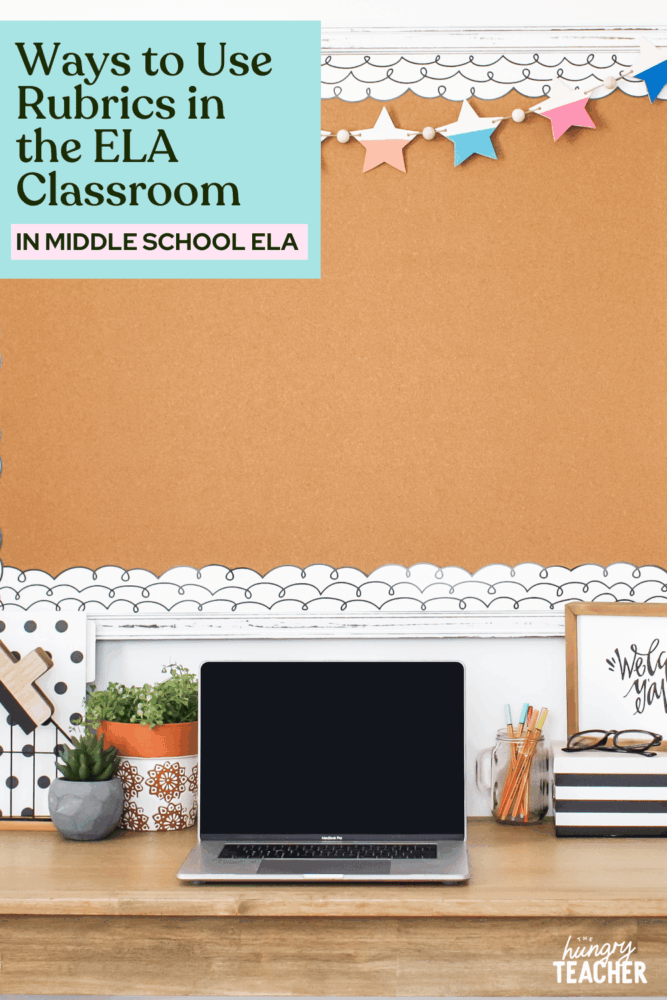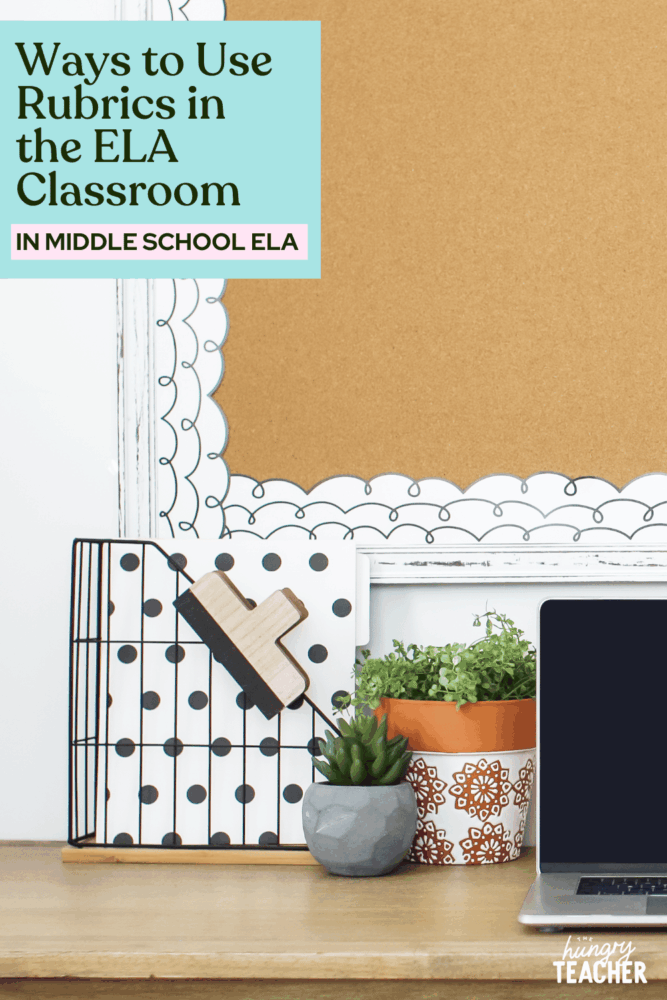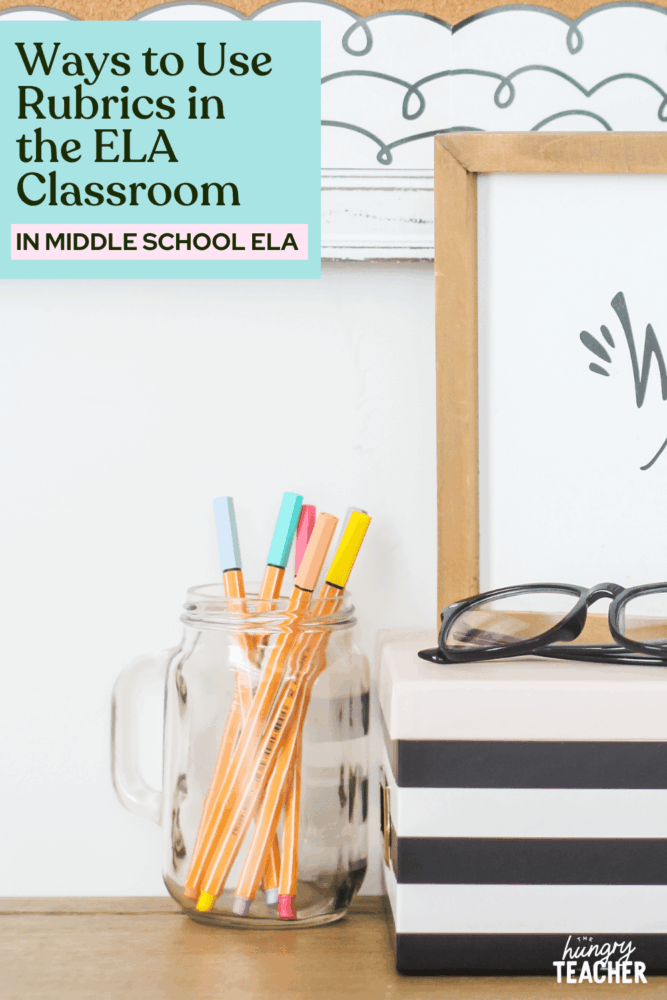hey friend!
I'm Martina.
I provide practical, time-saving strategies that actually work—so you can engage your students, teach effectively, and reclaim your time from the exhausting planning-grading cycle.
Browse Our ELA Resources
Ways to Use Rubrics in the ELA Classroom
Ways to Use Rubrics in the ELA Classroom
A rubric is one of the most valuable tools a teacher can have in their toolbox. Rubrics help simplify the grading process and requirements for all sorts of assignments. For a middle school ELA teacher, rubrics are a huge timesaver. Rubrics in the ELA classroom set the writing expectations for your students. It provides the information they need in order for them to earn a specific grade for an assignment.
Rubrics, however, go beyond grades. They also help students understand the process of where they are at in their writing, where they want to be to master the standards, and how to get there. Here are some ways to use rubrics in the ELA classroom.

WHY USE RUBRICS?
Rubrics serve many purposes other than just grading. Reading rubrics are great teaching tools because they put teachers and students on the same page. One of the most beneficial reasons to use a rubric is to simplify the grading process.
SIMPLIFY
Rubrics simplify the grading process and reduce the amount of time teachers spend grading work. In middle school ELA there are gray areas when it comes to grading and students may question why they received the grade they did.
A rubric takes the guesswork out of the “why” by explicitly explaining the expectations for the assignment.
In addition to being a powerful tool for teachers and students in the middle school ELA classroom, it is also a valuable resource for parents. It provides the instructions and expectations for parents. It gives parents a better understanding of their child’s grade while helping parents recognize what their child needs to be successful.

FEEDBACK
Rubrics also offer immediate feedback to students. They can analyze their own work to see where they may have deficits or strengths. Rubrics provide the map for students to see where they need to improve in their writing. It also makes the feedback process easier for teachers when students fully understand not just the “why” of what they’re working on but the “how”.
STUDENT OWNERSHIP
In addition, rubrics encourage students to take ownership of their learning. With regular use of rubrics, students can actually grade their own assignments. Rubrics help students take more responsibility for their work.
It’s also helpful to use rubrics in the middle school ELA classroom for peer feedback. When students analyze their classmates’ work, it provides another lens for them to see the grading process and to understand exactly what is expected of their work.
LITERATURE RESPONSE RUBRICS
Google the word “rubric” and it’s easy to fall down the rabbit hole. The websites, the resources, the “make your own” rubrics can cause a teacher’s head to spin while trying to pick the perfect rubric to use in the middle school ELA classroom.
Take the guesswork out of which reading rubrics to use with literature response rubrics that address all genres of writing.
These Middle School ELA rubrics are aligned to Common Core standards and can be easily edited to meet your needs. From argumentative, to reading informational, to reading literature, language, narrative, and range of writing, it’s all right here! Check out the Middle School ELA rubrics for immediate use.
Rubrics in the ELA classroom are extremely vital to your students writing skill set and critical thinking skills. Rubrics go beyond a grade for the end product. They are a “check for understanding” and help clarify for students the work they should be producing.
Literature response rubrics show students specifically the expectations, the criteria and the steps they need to take to get their writing to the next level.

NONFICTION READING RUBRICS
Nonfiction reading rubrics are essential to helping students understand how to write to inform. These reading rubrics target understanding of a nonfiction text and help to engage students in critical thinking skills.
Nonfiction reading rubrics address the main idea, theme, text structure, vocabulary, grammar, conventions, in essence everything that a regular writing rubric would assess.
However, it helps students understand the concept of informative writing while reading nonfiction texts.
One of the big advantages of nonfiction reading rubrics is to provide summarizing skills along with explanation and analysis. These rubrics can take on a variety of forms from cause and effect, compare and contrast to problem solutions. Each rubric can be separate and address a specific skill set.
When students understand the expectations and can identify what good writing is, they will grow as writers and lifelong learners. With rubrics in the ELA classroom, students are able to fully comprehend the elements and criteria necessary to earn a specific grade. Armed with this knowledge, students benefit by improving their writing and reading skills. As a middle school ELA teacher the benefits are limitless especially when you have the variety of middle school ELA rubrics at the click of a button.
MIDDLE SCHOOL ELA ASSESSMENTS
ELA quick check exit tickets are another great way to quickly check student’s understanding.
Click on each link above or for the complete bundle click here.
You can also try ten of each exit tickets for free:
Or check out each complete bundle here:
Want a sneak peek at teaching The Hungry Teacher way—with support, structure, and strategy?
When you join the waitlist for The Hungry Teacher’s Hub membership, you get three free classroom-ready resources: a theme unit, an expository writing unit, and a grammar unit introducing mentor sentences. Plus, you’ll get immediate access to a selection of exclusives from the Hub, including editable sub plans, pacing guides, and more.
No strings attached. Just resources you can use right now—and a heads-up when the Hub opens.
3 Free Middle School ELA Units—yours to keep!
JOIN THE WAITLIST + A FREE GIFT
Where to next, line leader?
Welcome to The Hungry Teacher! We create resources that are easy to use, practical, and get results. Teach with confidence—and make it home before dinner.
xo, the hungry teacher
